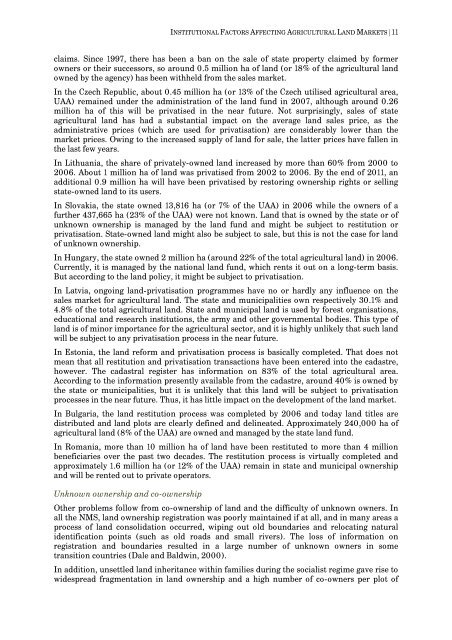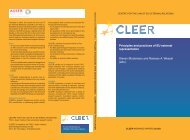Institutional Factors Affecting Agricultural Land Markets
Institutional Factors Affecting Agricultural Land Markets
Institutional Factors Affecting Agricultural Land Markets
Create successful ePaper yourself
Turn your PDF publications into a flip-book with our unique Google optimized e-Paper software.
INSTITUTIONAL FACTORS AFFECTING AGRICULTURAL LAND MARKETS | 11<br />
claims. Since 1997, there has been a ban on the sale of state property claimed by former<br />
owners or their successors, so around 0.5 million ha of land (or 18% of the agricultural land<br />
owned by the agency) has been withheld from the sales market.<br />
In the Czech Republic, about 0.45 million ha (or 13% of the Czech utilised agricultural area,<br />
UAA) remained under the administration of the land fund in 2007, although around 0.26<br />
million ha of this will be privatised in the near future. Not surprisingly, sales of state<br />
agricultural land has had a substantial impact on the average land sales price, as the<br />
administrative prices (which are used for privatisation) are considerably lower than the<br />
market prices. Owing to the increased supply of land for sale, the latter prices have fallen in<br />
the last few years.<br />
In Lithuania, the share of privately-owned land increased by more than 60% from 2000 to<br />
2006. About 1 million ha of land was privatised from 2002 to 2006. By the end of 2011, an<br />
additional 0.9 million ha will have been privatised by restoring ownership rights or selling<br />
state-owned land to its users.<br />
In Slovakia, the state owned 13,816 ha (or 7% of the UAA) in 2006 while the owners of a<br />
further 437,665 ha (23% of the UAA) were not known. <strong>Land</strong> that is owned by the state or of<br />
unknown ownership is managed by the land fund and might be subject to restitution or<br />
privatisation. State-owned land might also be subject to sale, but this is not the case for land<br />
of unknown ownership.<br />
In Hungary, the state owned 2 million ha (around 22% of the total agricultural land) in 2006.<br />
Currently, it is managed by the national land fund, which rents it out on a long-term basis.<br />
But according to the land policy, it might be subject to privatisation.<br />
In Latvia, ongoing land-privatisation programmes have no or hardly any influence on the<br />
sales market for agricultural land. The state and municipalities own respectively 30.1% and<br />
4.8% of the total agricultural land. State and municipal land is used by forest organisations,<br />
educational and research institutions, the army and other governmental bodies. This type of<br />
land is of minor importance for the agricultural sector, and it is highly unlikely that such land<br />
will be subject to any privatisation process in the near future.<br />
In Estonia, the land reform and privatisation process is basically completed. That does not<br />
mean that all restitution and privatisation transactions have been entered into the cadastre,<br />
however. The cadastral register has information on 83% of the total agricultural area.<br />
According to the information presently available from the cadastre, around 40% is owned by<br />
the state or municipalities, but it is unlikely that this land will be subject to privatisation<br />
processes in the near future. Thus, it has little impact on the development of the land market.<br />
In Bulgaria, the land restitution process was completed by 2006 and today land titles are<br />
distributed and land plots are clearly defined and delineated. Approximately 240,000 ha of<br />
agricultural land (8% of the UAA) are owned and managed by the state land fund.<br />
In Romania, more than 10 million ha of land have been restituted to more than 4 million<br />
beneficiaries over the past two decades. The restitution process is virtually completed and<br />
approximately 1.6 million ha (or 12% of the UAA) remain in state and municipal ownership<br />
and will be rented out to private operators.<br />
Unknown ownership and co-ownership<br />
Other problems follow from co-ownership of land and the difficulty of unknown owners. In<br />
all the NMS, land ownership registration was poorly maintained if at all, and in many areas a<br />
process of land consolidation occurred, wiping out old boundaries and relocating natural<br />
identification points (such as old roads and small rivers). The loss of information on<br />
registration and boundaries resulted in a large number of unknown owners in some<br />
transition countries (Dale and Baldwin, 2000).<br />
In addition, unsettled land inheritance within families during the socialist regime gave rise to<br />
widespread fragmentation in land ownership and a high number of co-owners per plot of








